The Critical Balance: Finding Your Freezer's Sweet Spot
What's the proper temperature for a freezer? The FDA recommends 0°F (-18 °C) for home freezers to ensure food safety and quality. Here's a quick reference:
| Freezer Type | Recommended Temperature |
|---|---|
| Home Freezer | 0°F (-18 °C) or below |
| Commercial Freezer | ‑10°F to 0°F (-23 °C to ‑18 °C) |
| Mortuary Freezer | ‑10°F to ‑20°F (-23 °C to ‑29 °C) |
Setting your freezer at the right temperature isn't just about keeping food frozen—it also protects against food-borne illness, reduces energy waste, and maintains flavor and texture. Too warm, and bacteria can spring back to life during thawing; too cold, and you burn extra electricity for almost no added benefit.
A common misconception is that colder always means better, but the science doesn't support this. At 0°F, food remains safely frozen indefinitely, though quality can decline over time. Every 5°F above this temperature cuts recommended storage time roughly in half.
I'm Alex, a refrigeration specialist with more than a decade of experience at American Mortuary Coolers, and I've helped hundreds of facilities—funeral homes included—dial in what's the proper temperature for a freezer for both everyday food storage and specialized mortuary applications.
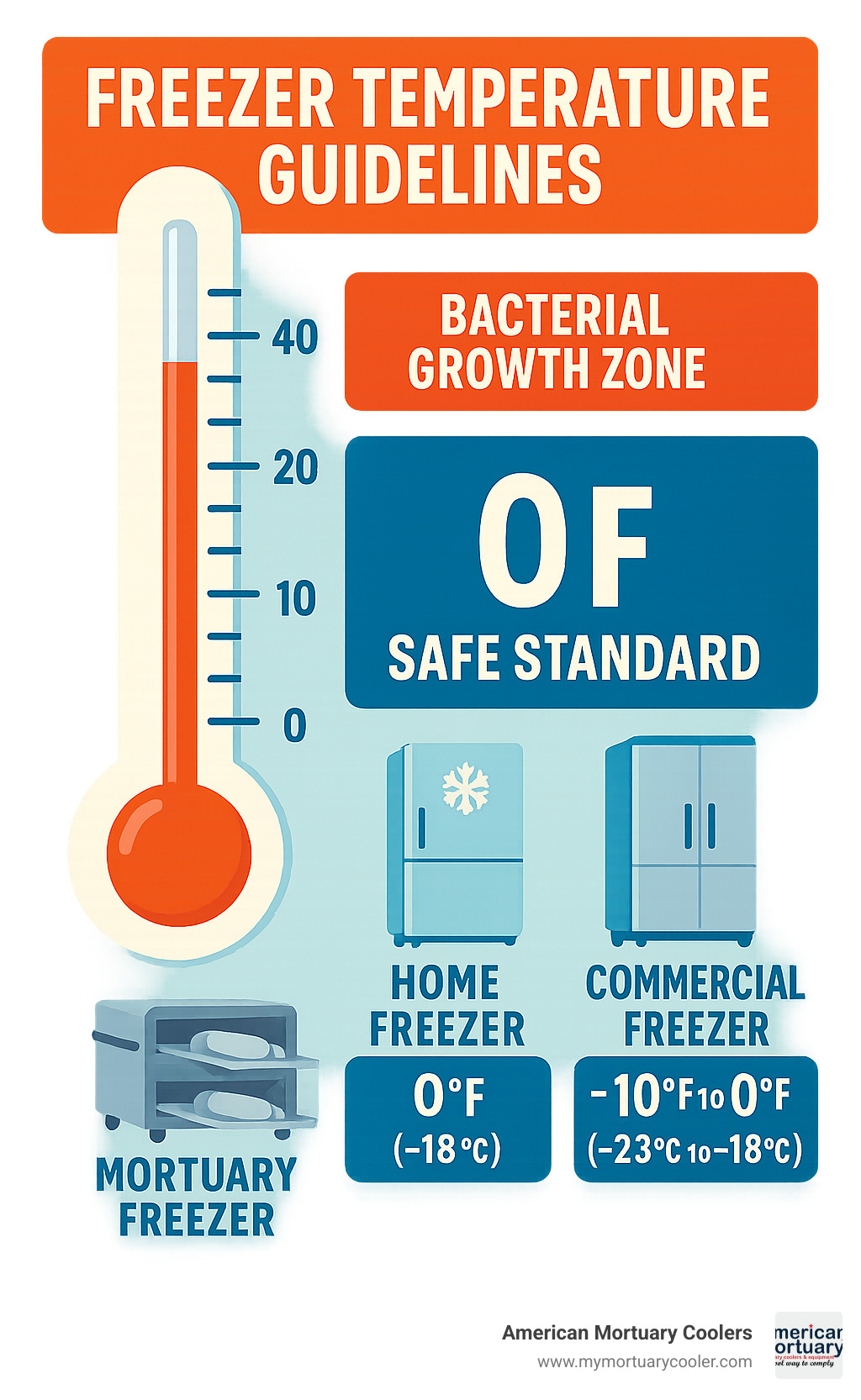
Relevant articles related to what's the proper temperature for a freezer:
What's the Proper Temperature for a Freezer?
According to the U.S. Food and Drug Administration (FDA), 0°F (-18°C) is the magic number for home freezers – a standard backed by both the Department of Energy and major appliance manufacturers.
This temperature isn't arbitrary – it's carefully chosen to keep your food safe while preserving its quality. At 0°F, food can be stored safely for months (sometimes even years!), with bacterial growth completely halted and nutritional value largely maintained.
For commercial freezers, the temperature range typically dips a bit lower, between -10°F and 0°F (-23°C to -18°C). This colder setting compensates for frequent door openings and the constant flow of products in and out throughout busy days.
In my work with specialized cooling systems, including mortuary freezers that we design at American Mortuary Coolers, we often recommend temperatures between -10°F to -20°F (-23°C to -29°C). These lower temperatures are essential for preserving biological materials with the utmost care and dignity.
For a deeper dive into the science of freezer safety, the FDA offers comprehensive research and guidelines that explain why these temperature standards matter so much.
Why 0°F Stops Bacteria Cold — what's the proper temperature for a freezer
Think of 0°F as nature's pause button for bacteria. At this temperature, microbial growth completely stops in its tracks. While freezing doesn't kill most bacteria (they're surprisingly resilient!), it prevents them from multiplying and producing the toxins that can make us sick.
What's the proper temperature for a freezer isn't just a casual question – it's fundamental to food safety. Once temperatures climb above 0°F, particularly during thawing, bacteria can wake up and resume their activities. The "danger zone" between 40°F and 140°F (4°C to 60°C) is where bacteria multiply rapidly especially above 40°F.
By maintaining your freezer at 0°F, you're creating an environment where harmful pathogens like Salmonella, E. coli, and Listeria remain dormant. Beyond safety, proper freezing also preserves most nutrients in your food. While some vitamins (particularly water-soluble ones like vitamin C) may decrease slightly during freezing, proteins, carbohydrates, and minerals remain well-preserved.
Can a Freezer Be Too Cold? — what's the proper temperature for a freezer
"The colder the better" seems logical when it comes to freezers, but this isn't actually true! Setting your freezer significantly below 0°F (-18°C) provides minimal additional benefits while potentially causing several problems.
When considering what's the proper temperature for a freezer, running a freezer at -10°F instead of 0°F can increase your energy bill by 5-20%, depending on your model and insulation quality. That's a significant cost increase without meaningful improvements in food safety or quality.
Many people believe super-cold temperatures prevent freezer burn, but that's actually a myth. Freezer burn happens when food is exposed to air (causing dehydration), not from cold temperatures themselves. Your best defense against freezer burn is proper packaging – removing air and using moisture-vapor-proof containers.
Your freezer's compressor will also thank you for not pushing it to extremes. Running consistently at very low temperatures forces the compressor to work harder, potentially shortening its lifespan and leading to expensive repairs or replacements.
Beginner Mistakes That Make Your Freezer the Wrong Temperature
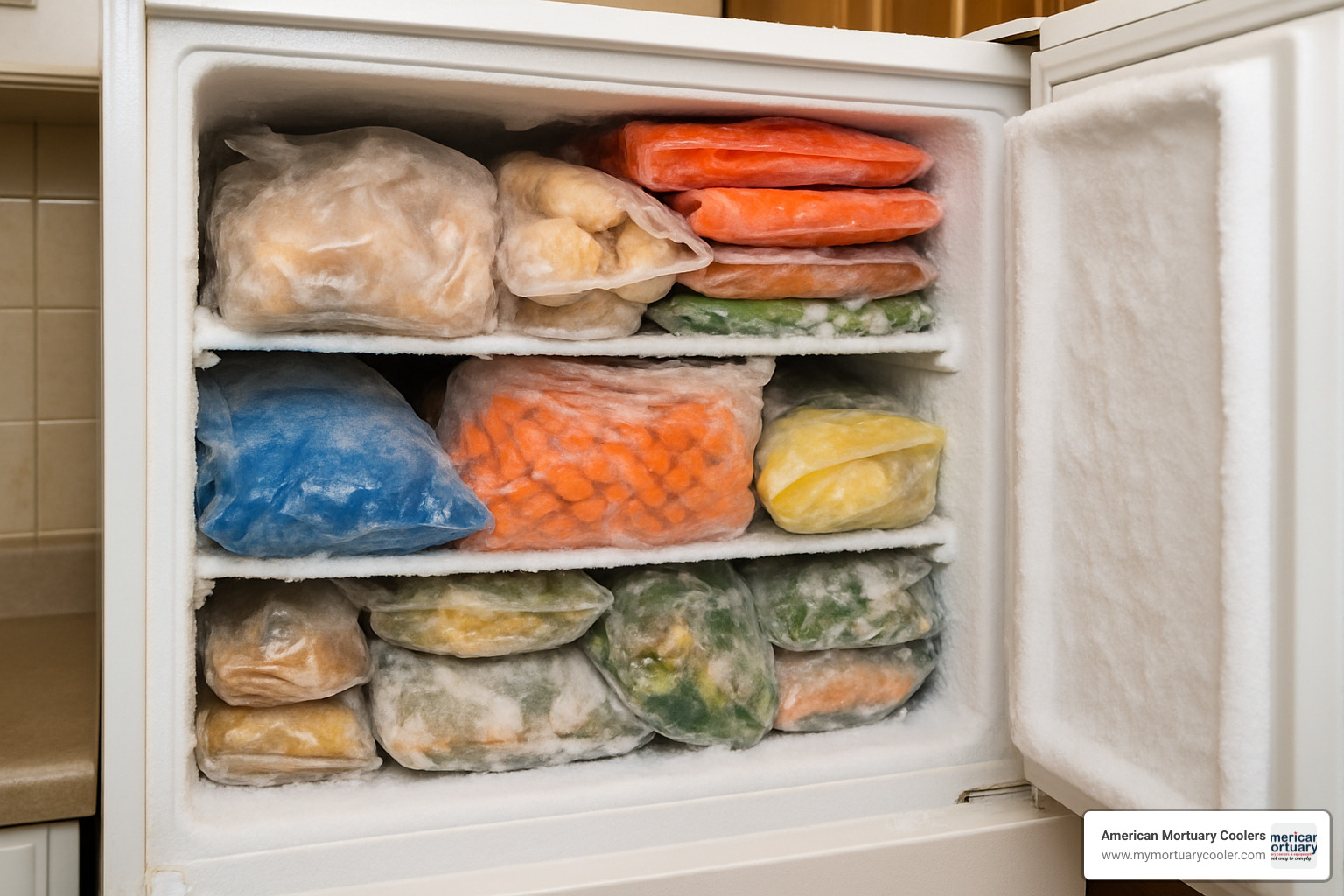
We've all been there—you open your freezer to grab some ice-cream only to find it's soft, or worse, your carefully stored food has developed mysterious ice crystals. Despite our best intentions, many of us unknowingly sabotage our freezers with habits that prevent them from maintaining what's the proper temperature for a freezer.
Relying on the Factory Dial Instead of a Thermometer
That little dial in your freezer with numbers from 1-7? It can be as unreliable as a two-week weather forecast. Many freezers, especially budget-friendly models, come with controls marked with arbitrary numbers rather than actual temperatures. Even that fancy digital display can be off by several degrees.
The fix is simple: invest in a standalone freezer thermometer. Place it near the center of the cavity (not on the door) and check after 24 hours. If you're not hitting 0°F, adjust and re-check the next day. For valuable inventory or power-outage-prone areas, consider a freezer alarm system.
Overpacking or Underfilling the Cavity
Finding the Goldilocks zone of freezer fullness is tricky. Many of us play freezer Tetris, cramming every last item until the door barely closes. Others keep their freezers nearly empty, with only a lonely ice tray and a forgotten bag of peas.
The sweet spot is about 75–80 % full—enough "thermal mass" to stay cold but still plenty of space for air circulation. A properly loaded freezer maintains temperature longer in a blackout and cools items more evenly.
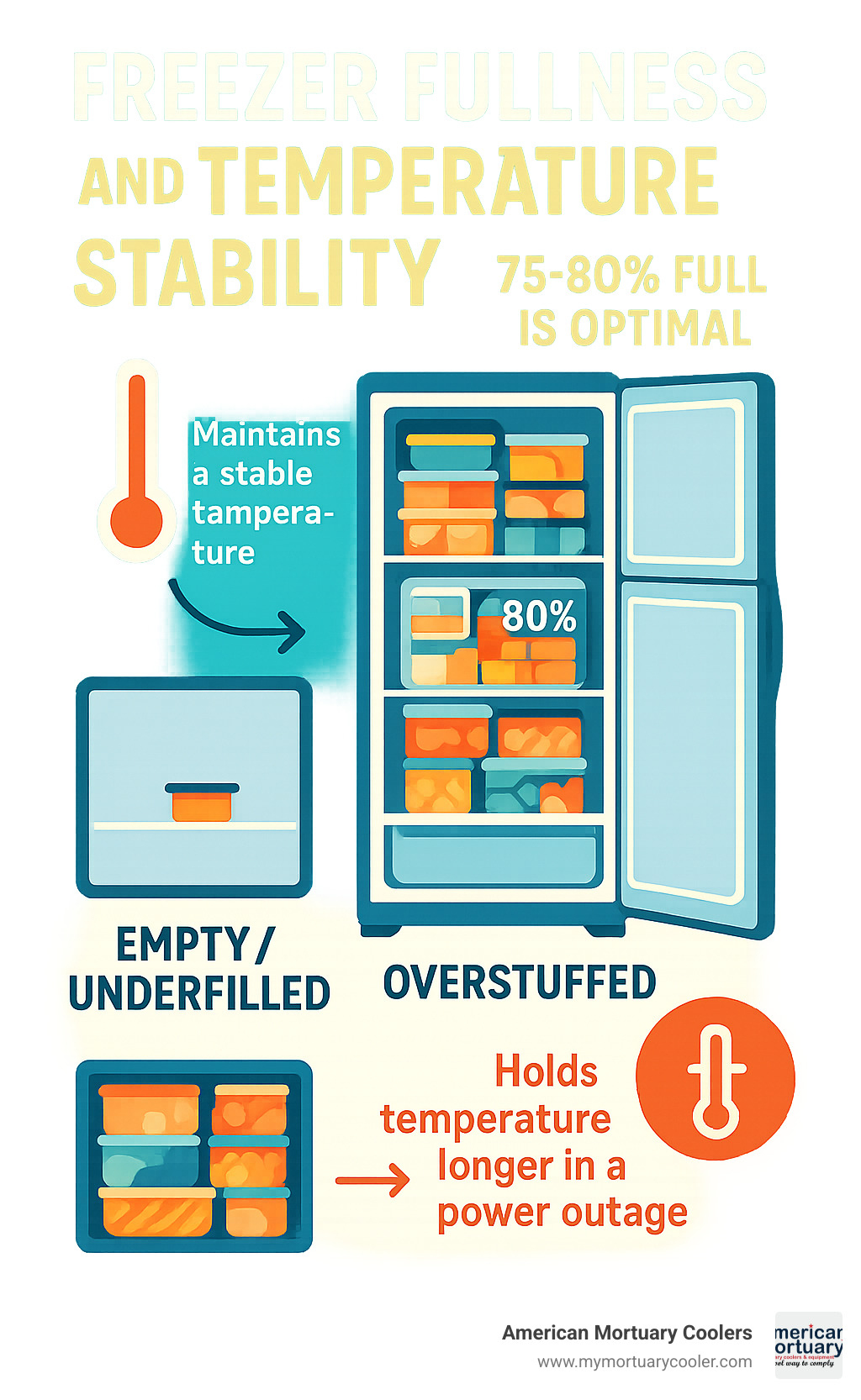
Ignoring Location and Ambient Climate
Your freezer doesn't exist in a vacuum. Hot garages in Phoenix or frigid Minnesota winters can force your appliance to work outside its comfort zone, leading to wild temperature swings. Whenever possible, place freezers in a temperature-controlled area away from direct sun or heat sources, and give them a few inches of breathing space for ventilation.
How to Check, Adjust, and Monitor Temperature Like a Pro
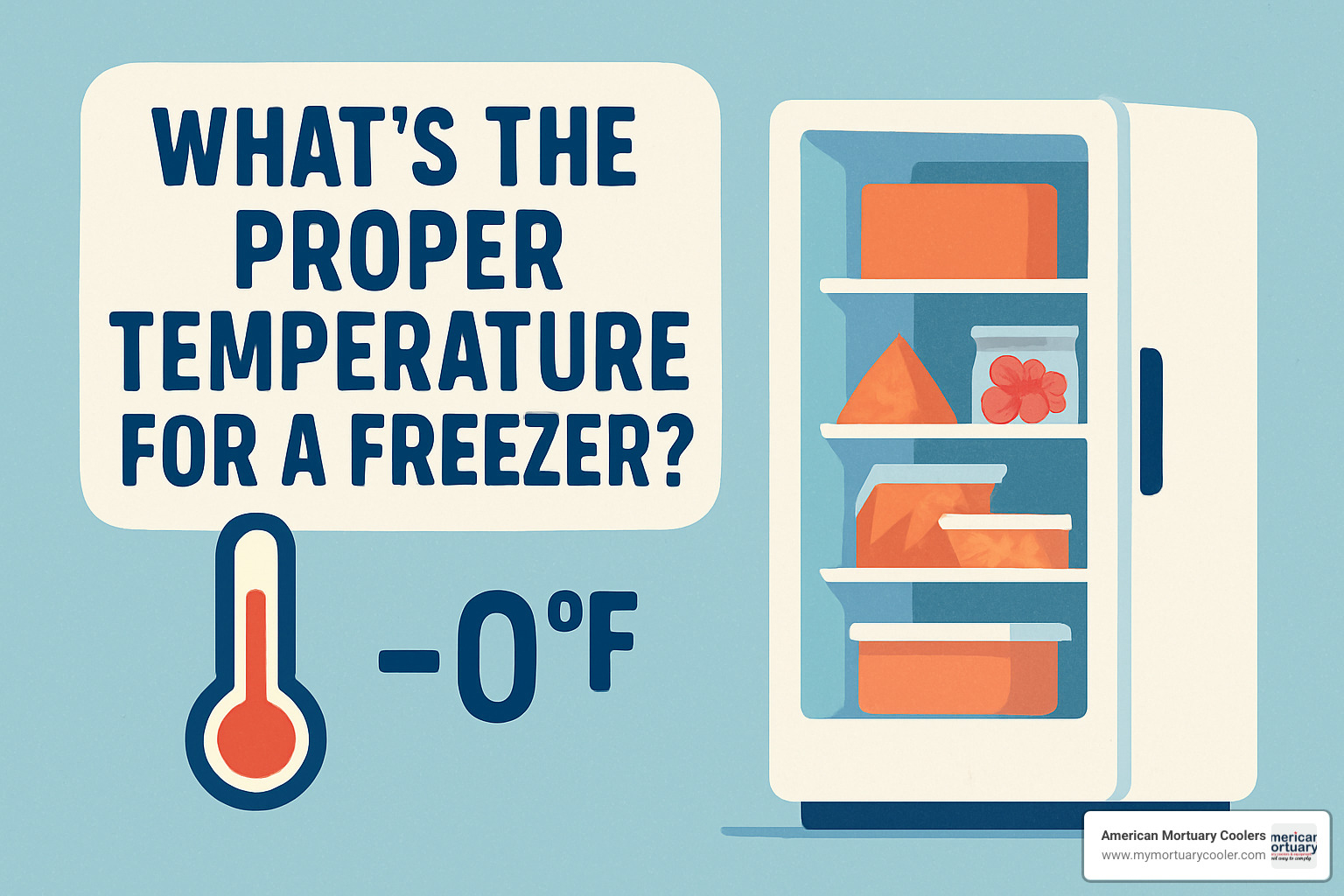
Let's face it—most of us don't think about our freezer temperature until something goes wrong. But knowing what's the proper temperature for a freezer and actually maintaining it are two different skills. The foundation of good temperature management starts with choosing the right thermometer.
| Thermometer Type | Pros | Cons | Approximate Cost |
|---|---|---|---|
| Dial/Analog | No batteries needed, simple to read | Less precise, can be hard to read | $5–$15 |
| Digital Probe | Accurate, easy to read | Requires batteries | $10–$25 |
| Wireless/Smart | Remote alerts to phone | Higher cost, setup required | $25–$60 |
For most homes, a basic digital thermometer works perfectly. They're affordable, easy to read, and accurate enough for everyday use. If you're storing expensive cuts of meat or other valuable items, wireless systems that send alerts to your phone can be worth the extra investment.
Step-by-Step 5-Minute Accuracy Test
- Fill a glass with crushed ice and just enough cold water to fill the gaps.
- Insert the thermometer probe into the center of the slush (don’t touch the sides or bottom).
- Wait 30 seconds; it should read 32°F (0 °C).
- If not, recalibrate or note the difference.
Once calibrated, place the thermometer in your freezer’s center, wait 24 hours, and fine-tune the controls if you're not at 0°F.
Power-Outage Playbook: Keeping Food Safe up to 48 Hours
A fully stocked freezer keeps food safe for about 48 hours (24 hours if half-full) as long as the door stays shut. Freeze a few water containers ahead of storm season to add extra "ice" mass. When power returns, keep or discard items based on whether the temperature stayed at or below 40°F and if ice crystals are still present.
Organizing and Loading Tips to Maintain the Right Temp
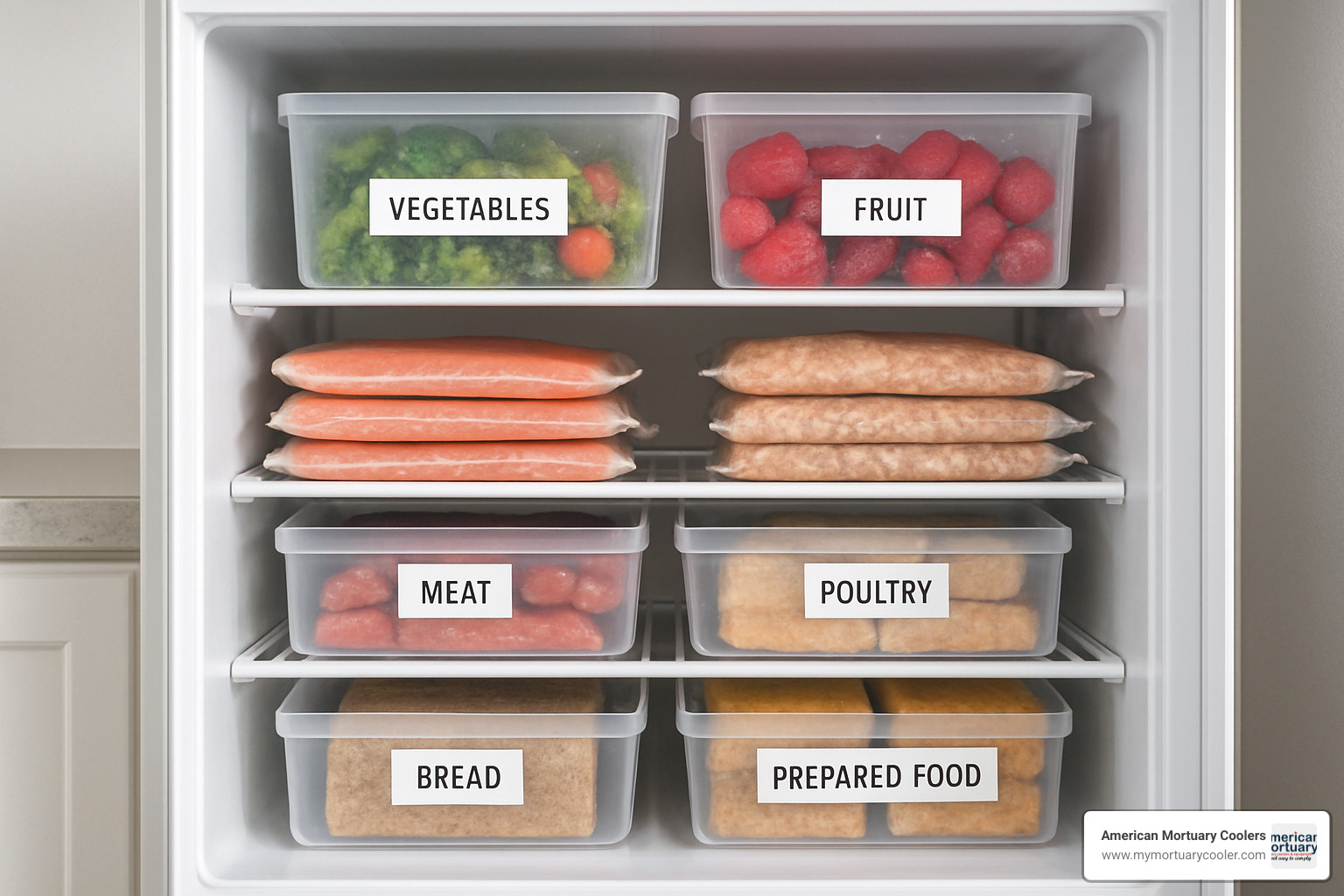
Standing in front of an open freezer while cold air pours out isn't just inconvenient—it actually raises the internal temperature. Smart organization keeps your food safe and your freezer running efficiently.
Think of it like a first-in-first-out (FIFO) dance: newer items go toward the back, older items toward the front. Clear, stackable containers and good labels (contents + freeze date) drastically cut door-open time.
Flat-freezing soups or ground meat in zipper bags saves space and speeds thawing. Leave a little breathing room so cold air can circulate, especially near vents.
Vacuum-sealing removes air, eliminating one of the main causes of freezer burn. When vacuum-sealing isn’t an option, press out as much air as possible or use the water-displacement method.
Special Considerations for Ice Cream, Fatty Fish, and Morgue Use
Ice-cream stores best at 0°F but scoops easiest at 6–10°F, so a brief counter rest works wonders. Fatty fish like salmon are oxidation-prone; keep them in the coldest zone (usually the bottom or back) and use within 2–3 months.
In our mortuary applications at American Mortuary Coolers, we maintain ‑10°F to ‑20°F for dignified, long-term preservation. The same core principles apply: steady temperature, good airflow, and airtight packaging.
Frequently Asked Questions about What's the Proper Temperature for a Freezer
After helping folks from Seattle to Miami set up their freezers, I hear the same questions again and again. Here are the big three:
How long can food stay frozen during a power outage?
A full freezer stays safely below 40°F for about 48 hours if the door remains closed. A half-full unit lasts roughly 24 hours. Check for ice crystals or refrigerator-level cold before refreezing.
Can I turn my freezer into a refrigerator?
Most standard freezers can’t reliably run at refrigerator temps. Their thermostats and defrost systems are designed for sub-zero operation, and humidity control is different. Some convertible models exist, but converting a regular freezer usually voids warranties and risks condensation or mold.
What does freezer burn really mean for safety?
Freezer burn is a quality issue, not a safety hazard. Dry, grayish patches are caused by air exposure and temperature swings. The food is safe but may taste off. Prevent it by using airtight, moisture-proof packaging and keeping the temperature consistently at 0°F.
Conclusion
Let's face it—your freezer is working hard for you 24/7, and giving it the right temperature setting is the least we can do in return! Maintaining your freezer at 0°F (-18°C) isn't just a random suggestion—it's the sweet spot where food safety, quality, and energy efficiency meet in perfect harmony.
Throughout this guide, we've explored why that magic number matters so much. At 0°F, harmful bacteria hit the pause button completely, your food maintains its nutritional value, and your freezer doesn't have to work overtime (saving you money on those electric bills).
Remember those common mistakes we discussed? Trusting factory dials without verification, cramming your freezer until the door barely closes, or placing it next to your oven—these seemingly small oversights can lead to big temperature problems. A simple freezer thermometer and some thoughtful organization can make all the difference.
For commercial settings, temperatures between -10°F and 0°F make sense with all those door openings throughout the day. And in specialized applications like mortuary storage (which we know a thing or two about at American Mortuary Coolers), temperatures between -10°F and -20°F provide the optimal environment for specialized preservation needs.
What's the proper temperature for a freezer isn't just a technical question—it's about protecting your family's food, reducing waste, and ensuring peace of mind. By monitoring regularly, organizing thoughtfully, and understanding the science behind freezing, you're well on your way to freezer mastery.
From our headquarters in Tennessee to our service areas across all 48 contiguous states, we at American Mortuary Coolers have applied these same temperature control principles to develop custom cooling solutions for funeral homes nationwide. Our specialized knowledge translates across industries—whether preserving food or providing dignified care in the funeral industry, temperature precision matters deeply.
For those in the funeral profession interested in learning more about our custom cooling solutions designed with your specific needs in mind, we invite you to explore more info about our cooler solutions. Our team crafts durable, custom refrigeration systems delivered directly to your facility, no matter where you are in the continental United States.


















